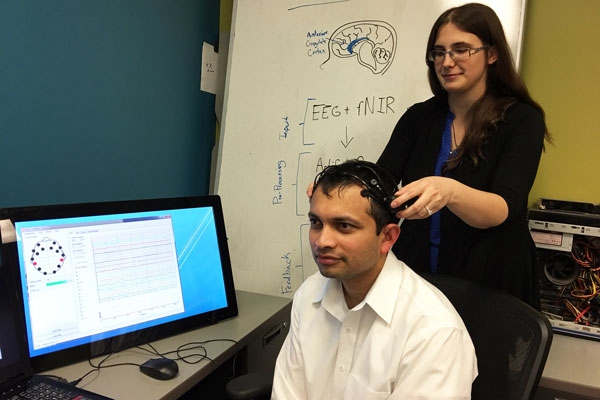Ohio Opioid Technology Challenge funds program testing neurofeedback-based brain training to reduce cravings and battle opioid addiction

Software engineer Kelly Cashion (right) adjusts a wireless EEG headset on research engineer Nilesh Powar. Credit: The University of Dayton Research Institute
_______
Battling Addiction With Brainpower (University of Dayton press release):
“The University of Dayton Research Institute has won a $10,000 Ohio Opioid Technology Challenge award for a program that will teach people with opioid addictions how to reduce their cravings by regaining control of their brains.
“Using neurofeedback, we’ll work with our volunteers to help them learn to regulate activity in the part of their brain associated with cravings and rewire some of those pathways, allowing them to reduce their cravings and experience a more ‘normal’ state even without opioids.” (says software engineer Kelly Cashion)
Neurofeedback is a type of biofeedback where sensors are used in conjunction with a brainwave monitoring method, such as electroencephalography (EEG), to help the wearer see his or her brain’s electrical activity in real time. The sensors — typically noninvasive and attached to the scalp in the form of a wireless headset or a more traditional “shower cap” style with wires — also let the wearer see if and when certain behaviors alter their brain’s electrical activity.
In her program, Cashion will show volunteers a graphics display — which she likened to a simple video game — on a computer monitor. By giving the volunteers tasks that require a shift in focus or other interaction with the game, they will see which activities most positively impact the signals associated with cravings. After a series of training sessions, volunteers will have learned the tasks they will need to perform to reduce cravings, even without use of the technology…Cashion said neurofeedback is not meant to be a substitute for, but a supplement to, current addiction therapies, which include medication assisted treatment and behavioral counseling.
At the outset of her program, Cashion will work with health care professionals and other experts to help establish a baseline of neurological signals and identify which signals are associated with cravings. She’ll work with other researchers in UDRI’s software systems group to use mathematical algorithms to map the 2‑dimensional baseline signal imagery to a 3‑dimensional map of the brain…
“Ultimately our goal is to develop and demonstrate a neurofeedback system that uses off-the-shelf hardware along with software developed here at the University of Dayton Research Institute, then work with local medical technology companies to commercialize the product and make it available to treatment centers,” Cashion said.
The Technology Challenge:
Ohio Opioid Technology Challenge, by Ohio Development Services Agency:
- Description: “Ohio is spending $1 billion annually attacking the opioid problem from every direction including prevention, education, treatment and recovery, and law enforcement. Recently, Ohio Governor John R. Kasich called for Ohio Third Frontier funding to accelerate scientific and technological breakthroughs that could help combat the U.S. opioid problem. The Ohio Third Frontier is a state initiative that identifies and advances promising technology…(it) will leverage $8 million of a $20 million commitment to advance new ideas in the battle against drug abuse and addiction. The Challenge is a multi-phase, multi-million-dollar prize competition with escalating prize amounts associated with progressive levels of solution development.”
The New Program in Context:
- FDA clears first CBT-based digital therapeutic to treat substance abuse disorders
- Study issues warning: Opioid inhibitor naltrexone (often used to treat addictions) can reduce feelings of social connection
- Can brain training work? Yes, if it meets these 5 conditions
- Presentation by Dr. Tom Insel during the 2017 SharpBrains Virtual Summit: Brain Health & Enhancement in the Digital Age (December 5–7th):


